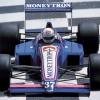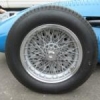Found this amazing resumé footage on youtube of the Belgian GP of 1955, a highlight of the weekend of that race:
Now interesting is that it also showed images of the practice sessions and the day before the race it was raining and during this session Mercedes engineer + test and apparently also reserve driver for this race, Rudolf Uhlenhaut, participated in that practice sesssion in the Mercedes T car that Stirling Moss also drove.
One can wonder if Uhlenhaut shouldn't be on the official stats of that race since he drove in an official F1 practice session, although only with the T-car. We've seen other GP's where drivers who only did a practice session are still mentioned as having participated in that GP Weekend. Now off course Uhlenhaut wasn't on the official entry list and he didn't have a number (the car he drove didn't have a number but the letter 'T').
The term T-car, for the back-up / reserve car, was still used well in to the '90s and early 2000s, I always asumed that term originated from the 'training car' but I'm unsure whether that's true, can anyone confirm this?
However Harry Schell, who had practiced in Trintignant's Ferrari nr.4 is mentioned as a 'non starter but practiced' in several sources but he wasn't on the official entry list! He might have been Ferrari's reserve driver that weekend but if he is mentioned then why wasn't Uhlenhaut mentioned?
There have been examples of third / reserve drivers who were mentioned in race reports. Gianbattista Guidotti comes to mind but he did have a race number on the entry list on both occassions (the British GP of 1950 and the Swiss GP of 1951) but he would never enter a race. Guidotti was a mechanical engineer and test driver for Alfa Romeo and someone who won the Mille Miglia together with Tazio Nuvolari back in 1930.
Now there was a driver that race on the entry list who didn't show up but he never appeared on any other F1 entry list. His name was Piero Valenzano and he was entered by the official Lancia team. He didn't show up because Lancia withdrew their works team shortly before the race, they still allowed Eugenio Castellotti to enter the race but as a private entrant. A third Lancia was initially entered for Luigi Villoresi.
Now I don't know much about Valenzano, just that he had also entered Le Mans that year in an official Maserati car. Looking at his profile at the oldracingcarswebsite there isn't much info about him, nor any noticable results, there either and his Le Mans entry isn't even mentioned there: https://www.racingsp...alenzano-I.html
So who knows more about Valenzano? Was he any good? He must have been a decent driver since the works Lancia team had entered him.
23 cars were officially entered for the Belgian GP of 1955 but only 16 of practiced that weekend (17 if you include Uhlenhaut in the 'T' car Mercedes), only 14 are mentioned in qualification (Schell was not and neither was Piero Taruffi who I assume may not have showed up at Spa that weekend, he was entered for Ferrari) and just 13 started the race, home driver (and talented Jazz music artist) Johnny Claes missed out on it with a broken engine on his Maserati, entered by Stirling Moss Ltd...
The Gordini's of Elie Bayol & Robert Manzon, like the Lancia factory team, didn't show up at Spa. Neither did the Filipinetti Gordini of Jacques Swaters, the second Vanwall of Ken Wharton (or maybe he was still there as a reserve driver? Only Hawthorn seems to have driven the Vanwall that weekend. The Maserati of Bira and the Ecurie Nationale Belge Ferrari of Gendebien didn't show up either.
So my questions about this weekend: - who was this Piero Valenzano really?
- Why was Uhlenhaut, who drove the Mercedes T car in an official practice session, nowhere mentioned in reports of that weekend?
- what is the origin of the term 'T-Car'? (does it come from 'training car' as I had always assumed?)
In the end this was one of the F1 races with fewest cars on the grid but nevertheless the race was pretty entertaining and Castellotti was awesome, scoring a pole position and raw pace during the race. Karl Kling also drove a pretty good race until his car broke down but Fangio & Moss were in a class of their own.
Edited by William Hunt, 30 May 2020 - 13:42.



















